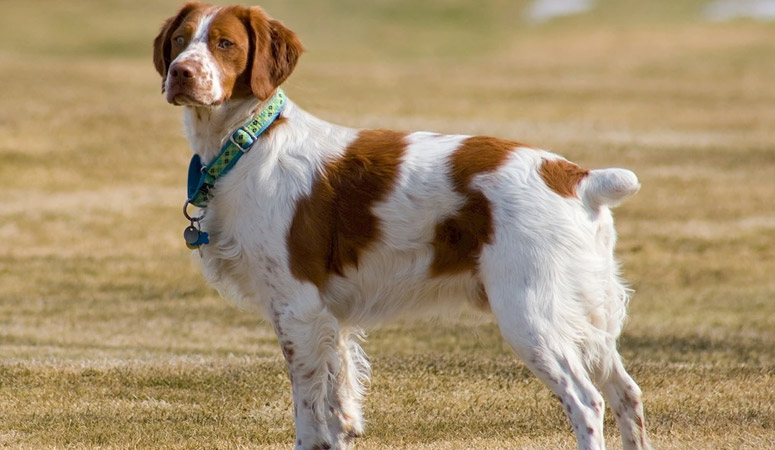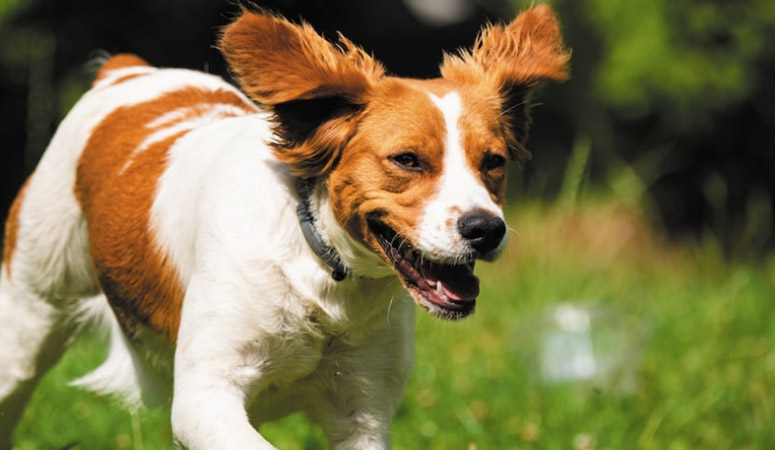Brittany

Once bred as an assistance of hunters, Brittanys are longlasting hunting companions as they are perfect for stamina and have an excellent nose for birds. Their alertness makes them assistant hunters, while their gentleness makes them favored by owners. They can accompany their favorite humans for a whole day without feeling boring. This breed can show intelligence, vigour, and alertness to more people as a quick learner.
| Other Names | Brittany Spaniel, Brittany Wiegref, Epagneul Breton, French Brittany |
| Color | Liver & White, Orange & White, Piebald |
| Height | Males: 18-21 inches. Females: 17-20 inches. |
| Weight | Males: 30-45 pounds. Females: 30-45 pounds. |
| Life Span | 12-14 years |
| Personality | Bright, Fun-Loving, Upbeat |
| Exercise | Needs Lots of Activity |
| Origin |
| Popularity | #26 |
| Groom Needs | 2-3 Times a Week |
| Kids Friendly | Yes with supervision |
| Dog Friendly | Yes with supervision |
| Watch Dog | |
| Family Dog | Yes |
| Litter Size | 5-8 |
Brittany Pictures
Brittany Video
Introduction
The Brittany is an athletic, sturdy, and exuberant dog breed that is cherished especially for its hunting abilities. Their short tails and high-set ears give them a characteristically sporty and portable appearance, especially as you watch them scuttle about their business. The beautiful, flowing coat of a Brittany comes in a finite variety of color patterns, including orange, liver, and black, often with white markings. There are tri-colored varieties too, mostly a combination of orange, black, and liver roan.
Although recognized as small, sporting dogs, Brittanys usually stand to a quite impressive height of about 18-21 inches from paw to shoulder, regardless of the sex of the dog. At 35-40 pound-weight the Brittanys are light enough to accommodate their agility and energetic behavior. Also important is the fact that Brittanys make for excellent gun-dogs, owing to their unique features described above. They are rambunctious, active dogs, and have an average life expectancy of 11-14 years.
Living with Brittany
Brittany’s flat or wavy coat is mostly fairly short and requires minimal grooming. These dogs don’t shed much, weekly brushing with a soft brush or hound glove and a quick comb-through of his featherings can keep their coat in good condition, and bath as needed. However, Brittanys used frequently for hunting will likely require baths more often, especially in the conditions that are wet and muddy.
The owner needs to check your dog’s ears once a week for the signs of infection such as redness or tenderness, and the underside of the ears should be inspected regularly and wiped clean if needed. Brush your dog’s teeth at least two or three times a week to remove tartar buildup and the bacteria that lurk inside it, the daily brush is better to keep fresh breathe and prevent gum disease. Besides, trim their nails as needed, or every couple of weeks.
Brittany is a highly energetic dog, so it is very important to provide him with a lot of exercise. A short walk around the block isn’t enough for him, at least an hour’s brisk walk, or half-hour brisk walk plus a half-hour at the dog park is better for him. If his basic need for exercise and a job to do isn’t met, your dog may get neurotic and hyperactive.
Brittanys are suitable for people who need an all-purpose hunting partner, a dog-sport teammate, or a loyal companion suited to a lively, outdoorsy family life. They enjoy long, brisk walks and hikes or running on a leash alongside their human, as well as the variety of activities. Brittanys require exuberant exercise every day, so they are not suitable for most apartment dwellers.
Generally, it is recommended to feed a Brittany with one and a half to two cups of high-quality dry dog food every day, divided into two meals. More importantly, the food amount should depend on the dog’s weight, size, age, and activity level. There should be fresh and clean water at all times.
Some dogs are easy to get overweight, so you need to watch their calorie consumption and weight level all the time. Treats may be an important aid in training, but excessive intake can lead to obesity. Also, owners need to distinguish which human food is safe for dogs and which are not. If you have any problems with your dog’s weight or diet, just consult from your veterinarian.
Brittanys are prone to the following health conditions: hypothyroidism, epilepsy, canine hip dysplasia, glaucoma…But overall though, these dogs are generally healthy.
Major concerns: CHD
Minor concerns: hypothyroidism, epilepsy
Occasionally seen: PRA, lens luxation
Suggested tests:
Hip Evaluation
Ophthalmologist Evaluation
Total Annual Cost: $2889
Cost is estimated for the first year and may vary depending on many factors, such as dog food, health care, leash, collar, licensing, possible fencing, crates, training and obedience classes, dog-walking, grooming, treats, toys, flea, tick, and heart-worm meds, microchips, etc.
Lively, smart, and with cheerful, willing character, Brittanys are easy to train in the basic commands, and they can do better with an abundance of positive reinforcement, praise, and dog treats. The owners need to know that they are sensitive to harsh treatment, the training outcomes would be better at any level with a gentle approach. It is more useful to train with patience, encouragement to these dogs.
Brittanys are strong contenders for any advanced sport, because of their boundless energy, curiosity, and athleticism. They can perform well in dog competitions, such as field training, obedience, agility training, flyball, and disc.
History
Originally called Brittany Spaniels, the dog breed has more in common with pointer and retriever breeds than it does with spaniels. However, like most spaniels, the Brittanys have an origin that can be traced back to the famous bird dogs of ancient Spain (called the Epagneuls). The history of the bird dogs, themselves, goes far back into the 1600s, while their Brittany descendants probably erupted around the early 17th century.
At any rate, the Brittany is widely believed to have originated and developed in France. The name itself was borrowed from the name of the French province where it likely developed. The Brittany Spaniels are probably hybrids descended from cross-breeding the old spaniels of France with some varieties of bob-tailed English Setters and retrievers which had occurred in the 19th century.
An orange- and white-colored Brittany was the first to be registered in 1907 when the breed was first recognized as a distinct breed in France. The following year, a Brittany club was formed in Loudéac and a standard was set for its breeding, which permitted the black nose and black coat varieties. However, on the arrival of the breed into the United States in the 1930s, its appearance was greeted with certain modifications to the standard for American Brittanys which forbade the black nose and black-coated varieties. The “Spaniel” in the name was dropped in 1982. Ever since the Brittany has grown in popularity and is ranked 26th most popular dog breed by the American Kennel Club.
Helpful Information
Breed Club: THE AMERICAN BRITTANY CLUB
Breed Club Link: http://www.theamericanbrittanyclub.org/
Breed Club Rescue: American Brittany Rescue, Inc.
Breed Club Rescue Link: http://www.americanbrittanyrescue.org/




